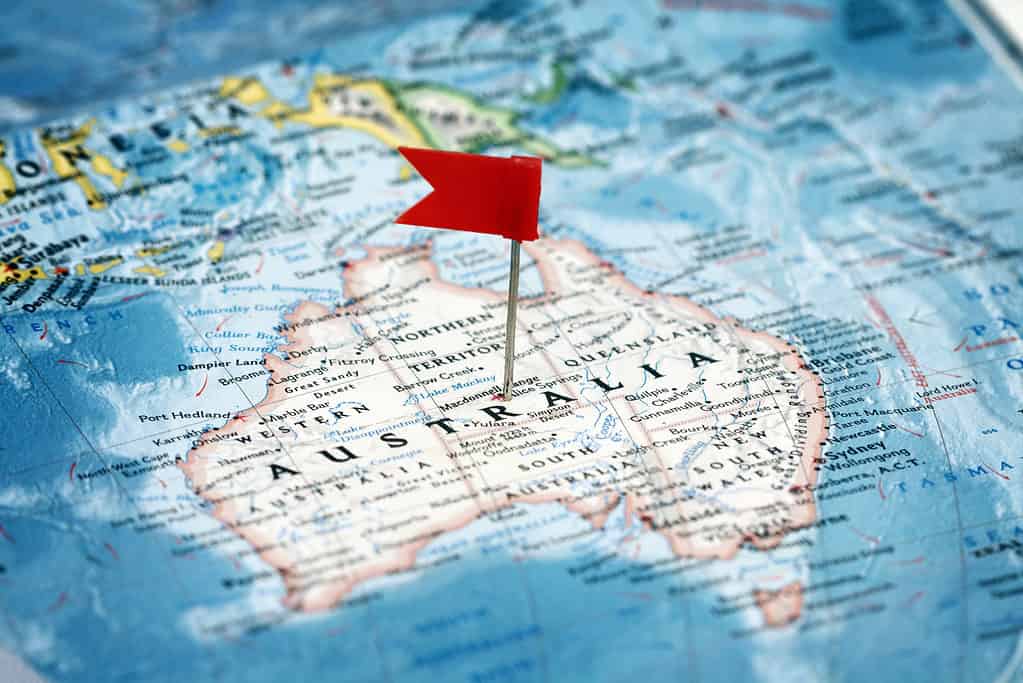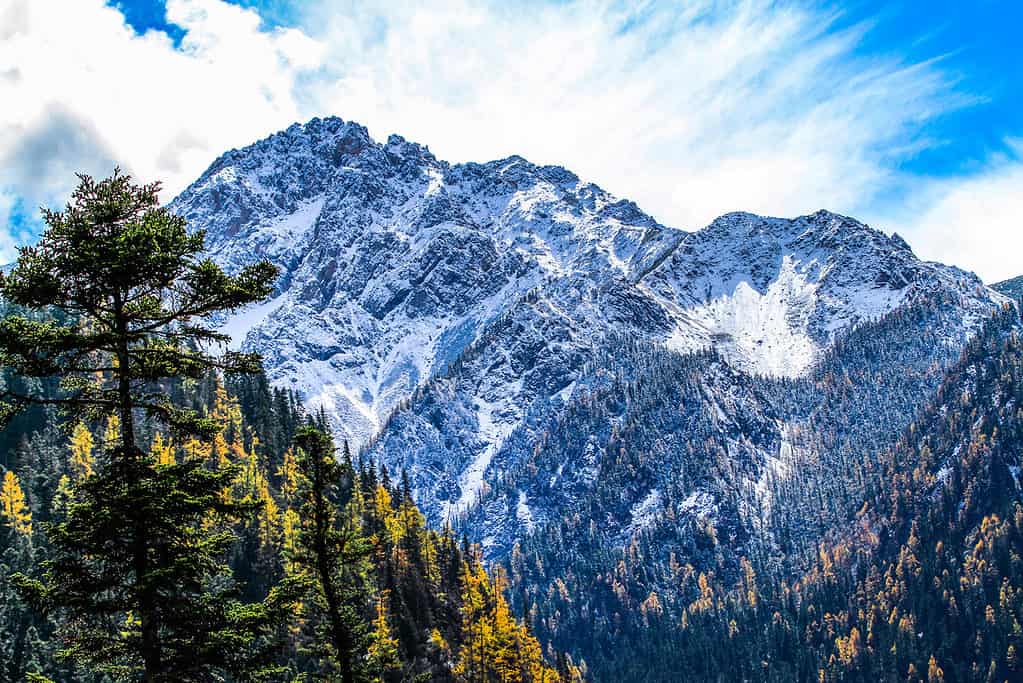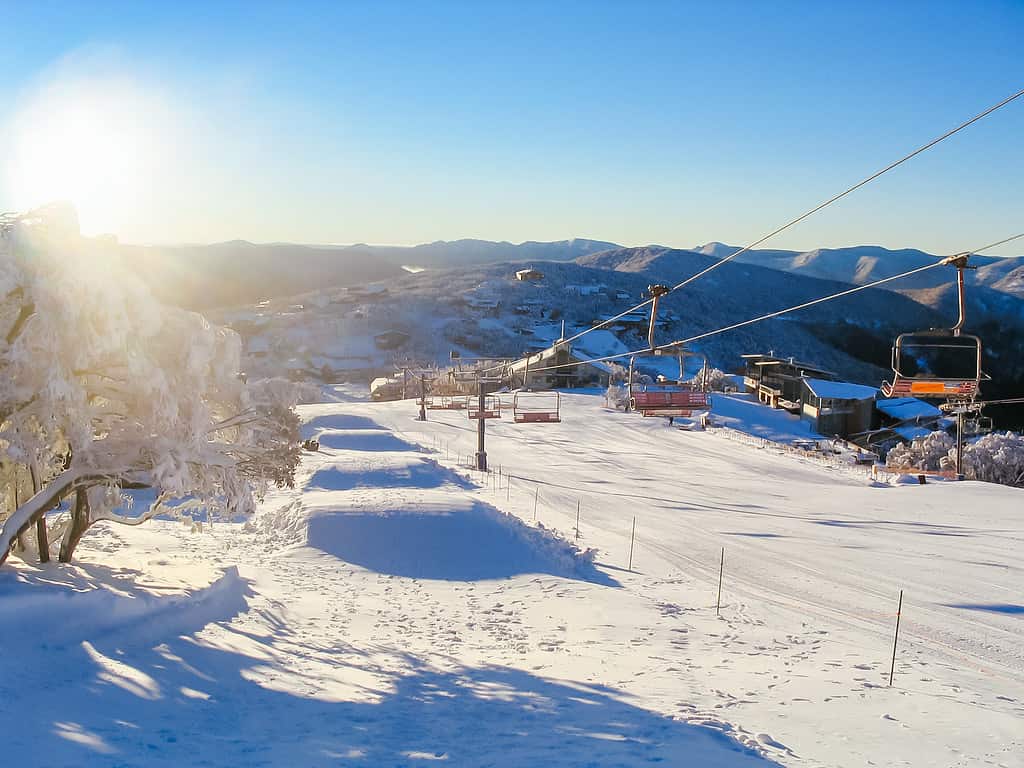When we imagine Australia, often the first images that pop to mind are the outback, beaches, kangaroos, and Uluru, but Australia has another side. Let’s discover the Australian Alps, including their size, location, and what epic animals live there.
Where Are The Australian Alps?

Australia’s Alps lie in the country’s southeast and take in three states.
©iStock.com/AlexKosev
The Australian Alps lie in Australia’s southeast corner. Over 4,760 miles stretch over Australia’s Capital Territory, New South Wales, and Victoria. The Alps are public land and officially protected. Nature reserves and 11 national parks comprise its incredible ecosystems.
- Located in New South Wales are the Bimberi and Scabby Range Nature Reserves, plus Brindabella National Park and Kosciuszko National Park.
- Australia’s Capital Territory is home to Namadgi National Park and Tidbinbilla Nature Reserve.
- Alpine National Park, Baw Baw National Park, Mount Buffalo National Park, Snowy River National Park (of TV fame), and the Avon Wilderness all sit in Victoria State.
Of all these wild spaces, Kosciuszko National Park is the largest. However, each state has a portion of low-altitude bogs and fens, plateaus, and lakes, through to snow-peaked mountains. The snowmelt from Australia’s Alps actually contributes to the entire nation’s river flow, its irrigation systems, and electricity generation.
Australian Alps: Size
Australia is mostly a flat country, but the Alps contain its highest point. Australia’s tallest peak is 7,310 feet tall Mount Kosciuszko in Kosciuszko National Park, but overall, the Australian Alps’ average elevation is just 1,082 feet above sea level.
Other notable high peaks include 7,247-foot Mount Townsend, which is only two miles from Mount Kosciuszko, 7,201-foot Mount Twynam, and Rams Head, towering at 7,190 feet.
Compared to the world’s tallest peaks, the Australian Alps don’t have a great deal of elevation. Here are some of the planet’s most towering heights:
- Mount Everest’s staggering 29,035 feet in Asia
- Mount Aconcagua at 22,837 feet in South America
- Mount Denali at 20,310 feet in North America
- Mount Elbrus at 18, 510 feet in Europe
- Mount Kilimanjaro, 19,341 feet in Africa
Despite the Australian Alp’s shorter stature, they still create outstanding ecosystems and a huge variety of incredible flora and fauna, not to mention epic skiing. We’ll look at what visitors can do there a bit later on.
What Created the Australian Alps?
A rift created the Australian Alps. 100 million years ago, New Zealand parted ways with Gondwanaland and created this unique landscape. Most alps form when tectonic plates collide, so Australia’s alp formation is unusual.
History of Australia’s Alpine Regions

7,310 feet tall Mount Kosciuszko is the highest point in Australia.
©iStock.com/chengwaidefeng
Australia’s pre-history is beautifully displayed by its alp formation. Fish fossils and glacier patterns found in the landscape indicate life there before humans.
For thousands of years, aboriginal tribes lived and made use of the alpine regions. Many of their incredible songs and stories are still sung today. An aboriginal meeting unique to the Australian Alps is the social gathering for Bogong moth feasting, a moth unique to this area.
Then, as settlers arrived, the Australian Alps became distinctive pioneering landscapes. The area is dotted with huts and stock routes that mark settlers’ sheep grazing activities and the pioneer lifestyle beautifully described in the poem The Man From Snowy River.
Animals In The Australian Alps
Australia’s traditional kangaroo is found on some of the lower alpine slopes in national parks, but alpine conditions are usually too cold for this marsupial. No traditional koalas, dingoes, or brumbies climb high, either.
Animal life in the Australian Alps is adapted to the cold. Mount Kosciuszko reaches minus degrees in winter with blizzards, strong winds, and heavy snowfall. The higher alpine regions remain below 10 degrees for at least four months of the year.
The Australian Alps are home to over 40 native mammals, 30 reptiles, over 200 bird species, and 15 types of amphibians. It’s a unique place like no other on the planet.
Here are a few of the rarer Australian Alps inhabitants:
Mountain Pygmy Possum
This small marsupial lives in the subalpine and alpine regions. They are Australia’s only alpine mammal living between 4,270 and 7,320 feet elevation.
These tiny marsupials reach a maximum of 4.3 inches long with a prehensile tail that’s a shade longer than their total body length. A mountain pygmy possum weighs just 1.6 ounces. It has a thick, gray coat with a creamy underside to keep warm, and females have a pouch to carry their babies.
Bogong Moths
We’ve read about aboriginals feasting on Bogong moths, but what are they, exactly?
Bogong moths are brown, night-flying moths with a wingspan of around two inches. They flock to caves in the Australian Alps during the summer months, flying over 600 miles from western Victoria, western New South Wales, and southern Queensland.
Platypus

Platypus (
Ornithorhynchus Anatinus) is one of just two egg-laying mammals on Earth.
Shy platypuses live in the Australian Alps’ rivers and lakes. These Australian native creatures have duck-like bills to gobble down aquatic insects at dawn and dusk and a flat tail to propel through water. Platypuses are unusual because they’re egg-laying mammals called monotremes. It’s very rare to spot one, but they prefer to live in the lower, warmer regions.
Short-beaked Echidna
Ant-munching short-beaked echidnas live in the sub-alpine Australian Alps, emerging from their burrows at night to capture prey with echolocation. Like platypuses, they are egg-laying mammals, but short-beaked echidnas don’t live in water. Instead, spiky armor made from keratin spikes protects their skin.
Eastern Brown Snake
Australia is the land of “nope” animals, so it’s no surprise that the Alps region is home to a seven-foot-long, highly venomous snake called the eastern brown snake. It’s a shy animal that rarely bites humans. In fact, it’s rarely seen. It preys on rodents and birds in the lower alpine regions.
Guthega Skink
The Guthega skink is Australia’s highest-living skink. It’s a rare skink indeed because it only lives in Kosciuszko National Park and the Victoria Alps at an altitude of over 5,249 feet. Many folks know this cute reptile as the Snowy River skink.
Notable Plants
Even though the Australian Alps are short compared to worldwide alpine regions, they have an array of epic plants, including snow gums, bogland ferns, and wildflower meadows dotted with alpine daisies and yellow billy buttons.
Eucalyptus and alpine ash forests stretch for miles, but at harsh peaks above the tree line, fewer plants grow. Tough snow gum is the primary plant here, plus low-growing alpine herbs.

Mountain ash forests grow in lower alpine regions. Above them, it’s chiefly snow gum.
©Graham Drew Photography/Shutterstock.com
Can I Visit the Australian Alps?
Yes, the Australian Alps are easily accessible. Visitors can ascend Mount Kosciuszko by chair lift at Thredbo’s ski village park. Until 1977, visitors could drive to the peak, but environmental concerns meant officials closed the road. It hasn’t put off visitors, though. Over 100,000 intrepid folks take the chair lift to Mount Kosciuszko’s peak each year.
What Can You Do There?

Skiing in the Australian Alps is a popular winter sport.
©FiledIMAGE/iStock via Getty Images
Snow sports are popular in the Australian Alps. Skiing, snowboarding, snowshoeing, and very popular cross-country skiing are offered all winter. In a few resorts, dog-sledding and snowmobiling attract tourists.
Hiking
There’s incredible hiking, too, and many paths wind to the topmost peaks. Take appropriate clothing and enough water, and choose a relatively easy route unless you are experienced enough to tackle an alpine trek across Kosciuszko Summit or Thredbo Valley Track.
Mountain Biking
Wherever there’s an up, there’s a down! Downhill mountain biking is a popular activity for daredevils in the alpine regions. Dedicated tracks keep bikers and pedestrians safely apart.
Wildlife Watching
We’ve looked at the Australian Alps’ epic wildlife, so what could beat trekking to tick off your ‘to see’ list? Start with lower alpine creatures like platypi, move to montane Bogong moths, and finally, higher alpine pygmy possums and Guthega skinks.
A Driving Tour
Mount Kosciuszko’s summit road is closed, but there are many epic driving tours throughout the Australian Alps. The Great Alpine Road takes tourists on a 300 km trip from Victoria to Gippsland, and a popular Snowy River to Jindabyne route takes in not only the famous Snowy River but the lower part of Kosciuszko National Park, too.
The photo featured at the top of this post is © Greg Brave/Shutterstock.com
Thank you for reading! Have some feedback for us? Contact the AZ Animals editorial team.






